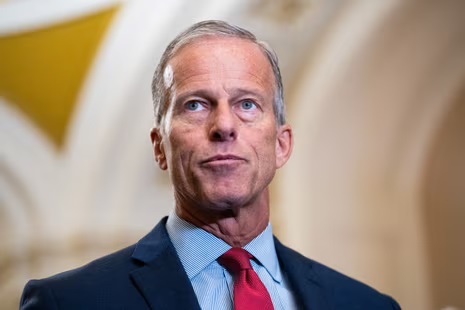 Alyssa Schukar for Education Week
Alyssa Schukar for Education Week
Dear Commons Community,
On Tuesday evening, one of my graduate students asked during class “Can the U.S. Department of Education be abolished?” It was a good question and I gave a lengthy answer basically coming to a conclusion that it would not be easy to accomplish given the fact that such a move would have to be approved by Congress and there are many senators and representatives whose states benefit from its policies. However, that does not mean that certain programs could not be abolished or having funding significantly reduced. Education Week had an article that speculated on the USDOE under Trump. Its messaging coincides with much of my thinking.
Below is the entire article.
Tony
——————————————
Education Week
Can Trump Really Dismantle the Department of Education?
It’s not impossible, but many of its functions would need to move elsewhere
By Evie Blad — November 07, 2024
Plans to abolish the U.S. Department of Education—a key part of President-elect Donald Trump’s platform and a priority for his political allies—are a key concern for schools as he prepares to retake the White House in January.
But can he—and will he—actually carry through on the promise? And what would it mean if he did?
The short answer: Ending the agency would require approval from Congress and a great deal of political capital that Trump may want to target elsewhere, especially in the early days of his administration in which he will be under pressure to deliver promises around tax cuts and immigration. But it is possible.
Trump attempted to dismantle the Education Department in his first term, but his efforts got little traction. His supporters say he may have a clearer path to accomplishing his priorities with the momentum of reelection. And with the help of a Republican-controlled Senate and the possibility of a Republican-controlled House of Representatives, Trump is likely to pursue plans to scale back and consolidate some federal programs, even if he doesn’t fully end the agency.
Here are five critical things to know.
Republicans have a long history of unsuccessful efforts to kill the U.S. Department of Education
Republican presidents and presidential candidates have threatened to end the U.S. Department of Education since it was first established as a cabinet-level agency under former President Jimmy Carter in 1979. Before then, all enforcement of federal education laws fell under the purview of the U.S. Department of Health, Education, and Welfare, which was renamed the Department of Health and Human Services when the law was enacted.
As Education Week reported in August, efforts to end the agency started before the ink on Carter’s signature on that bill was dry.
The best chance for getting it done may have come in 1981, when former President Ronald Reagan’s Education Secretary Terrel H. Bell drafted a 91-page memo about converting the nascent federal agency to a small foundation that would conduct research and provide support but “avoid direction and control.”
That plan faced resistance in Congress and, later, from Bell himself, who believed the federal government had a role in ensuring schools confronted “a rising tide of mediocrity” in American education.
In 1981, Reagan signed the Education Consolidation and Improvement Act, which reduced federal regulations for Title I, a grant program that provides extra money for schools that enroll large amounts of students from low-income households. But his plans to end the Education Department fizzled.
Before Trump, the last presidential candidate to call for abolishing the Education Department in the party platform was Sen. Bob Dole, who lost to former President Bill Clinton in 1996. Former President George W. Bush, who was elected in 2000, favored a stronger federal role, and that philosophy became the basis for No Child Left Behind, a bipartisan law that introduced new requirements for testing and accountability as a condition of federal funding.
The U.S. Department of Education’s role includes civil rights enforcement, student loans
The Education Department’s largest K-12 role is overseeing implementation of the Every Student Succeeds Act, which requires states to monitor their schools’ progress and intervene in poorly performing schools in exchange for federal money, including funding from Title I, an $18.4 billion program.
The department also administers the Individuals with Disabilities Education Act, or IDEA‚—a $14.2 billion program that helps schools pay for special education services for students with disabilities—and a portfolio of grants related to school safety, teacher training, and workforce preparation.
In 2020-21, the most recent school year for which federal data are available, the federal government was responsible for 10.6 percent of the nation’s spending on public schools, and that share was elevated due to the infusion of COVID-relief funds.
The Education Department ensures compliance with federal laws that protect civil rights and disability rights in public schools. That includes investigating complaints that schools aren’t doing things like meeting the needs of students with disabilities, responding adequately to sexual harassment or bullying, or ensuring fair treatment for students of color.
The agency also collects data on a range of issues, including school safety, student discipline, the teacher workforce, and civil rights.
In higher education, the Education Department oversees the Free Application for Student Aid, or FAFSA, and the massive federal student loan and grant programs (the federal direct student loans program has a portfolio of outstanding loans totaling over $1 trillion).
There’s widespread misunderstanding among the general public about the Education Department’s role, policy advocates say. The agency does not dictate what educators teach, and the funding it administers makes up a relatively small portion of school funding compared to state and local revenue.
Some significant federal education programs in schools are administered by other agencies. Head Start, the early childhood education program, is administered by the U.S. Department of Health and Human Services; and the National School Lunch Program is administered by the U.S. Department of Agriculture.
Why Republicans want to shutter the Education Department
Conservatives who support closing the Education Department see the agency as a symbol of a bloated federal bureaucracy and an infringement on states’ rights under the 10th amendment of the U.S. Constitution, which says that powers that aren’t specifically enumerated to the federal government are the responsibility of states.
But supporters of the agency say it plays an important role in ensuring students are treated fairly and helping states raise the bar for school performance.
Even if Trump got congressional approval to shut down the agency, he would have to move its responsibilities—managing student loans and administering existing funding streams—to other agencies. Critics say that wouldn’t have a meaningful effect on the federal education footprint, because the department’s programs would still exist in federal law, though the administration could ask Congress to revoke them or to zero out funding for them.
Trump tried and failed to axe the Education Department in his first term
During his previous term, Trump proposed merging the department with the U.S. Department of Labor in a 2018 plan that never got off the ground. He also proposed converting 29 existing federal programs into a flexible block grant, a proposal Congress rejected.
Trump supporters have continued those calls during the 2024 campaign.
Trump has not detailed how he would close the Education Department, a proposal that’s mentioned only broadly in his campaign rhetoric and in the GOP platform.
Project 2025, the conservative policy document spearheaded by the Heritage Foundation and written by a number of former Trump aides and allies, proposes scrapping the department and making major changes to the two major K-12 funding streams it oversees: converting funding for the Individuals with Disabilities in Education Act into “no strings attached” block grants to states and ending Title I.
Why Trump is likely to face resistance
As the saying goes, all politics is local. That’s especially true for school districts, the most local form of local government.
Schools are in a financially complicated position this year as they slim down their budgets to deal with declining enrollment and the end of federal COVID-19 aid.
Superintendents and school boards are likely to fight against the reduction or elimination of federal funding streams that help them stay out of the red. And every member of Congress will likely hear from those influential community leaders as they weigh any proposal to do so, Margaret Spellings, who served as U.S. Secretary of Education under Bush, told Education Week in August.













